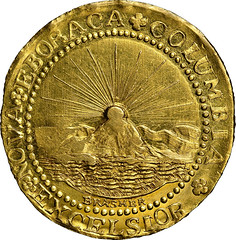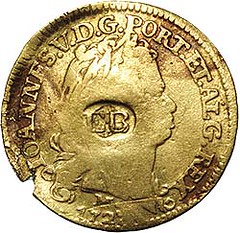
PREV ARTICLE
NEXT ARTICLE
FULL ISSUE
PREV FULL ISSUE
BRASHER DOUBLOON REALIZES $4,582,500 AT HERITAGE AUCTION
Coin Update published a short article by Dennis Hengeveld on the 1787 Brasher Doubloon sold at this week's FUN show. But the Heritage catalog description has much more background on the famous coin. Here are some excerpts.
-Editor


To understand the importance of the Brasher doubloon it is necessary to know something about its creator, a multi-faceted man named Ephraim Brasher. Brasher was a man of many accomplishments and fairly well known in his time, but history had largely forgotten him until scholars began researching his life in conjunction with his numismatic legacy. Much has been learned about Brasher and his coins in recent years, but some questions remain unanswered.
Ephraim Brasher, Silversmith, Patriot, and Businessman One of Brasher's chief claims to fame was that he lived just a few feet from President George Washington in New York City after the war. Washington resided at 3 Cherry Street and Brasher lived next door at 1 Cherry Street. Not only were Washington and Brasher neighbors, but Washington was also a customer of Brasher. He owned numerous silver pieces made by Brasher, including a number of silver skewers with a surviving receipt. It was certainly important for Washington to make a good impression at state dinners, which he did with the assistance of his Brasher silver.
Brasher's Private Coinage
The New York Style Doubloons Obverse: The obverse was apparently adopted from the state coat of arms of New York. The sun is rising over the peak of a mountain with a body of water in the foreground. Brasher's name is spelled out below the waves, in small letters. This central device is enclosed within a circle of beads. The legend, around: NOVA EBORACA COLUMBIA EXCELSIOR has each word separated by a rosette. The legend translates to New York, America, Ever Higher. Excelsior remains the state motto to this day. Reverse: An eagle with wings displayed, and a shield covering its breast, has a bundle of arrows in its sinister claw (to the observer's right) and an olive branch in its dexter claw. Thirteen stars surround the eagle's head. This central device is enclosed in a continuous wreath. Around, the legend: UNUM E PLURIBUS with the words separated by stars. This legend translates to One of Many. Below, the date 1787 is flanked by rosettes. Many of these devices are similarly used on the Great Seal of the United States. Like many coins of this era, the denomination was not specifically expressed anywhere on the coin. To read the complete lot description, see: 1787 DBLN Brasher Doubloon, EB on Wing, W-5840 (coins.ha.com/c/item.zx?saleNo=1201&lotIdNo=79001)
To read the Coin Update article, see:
Finest Certified 1787 Brasher Doubloon Realizes $4,582,500
(news.coinupdate.com/finest-certified-brasher-doubloon-auction-result-3100/)
The Numismatic Bibliomania Society is a non-profit organization promoting numismatic literature. See our web site at coinbooks.org. To submit items for publication in The E-Sylum, write to the Editor at this address: whomren@gmail.com To subscribe go to: https://my.binhost.com/lists/listinfo/esylum All Rights Reserved. NBS Home Page Contact the NBS webmaster 
|
